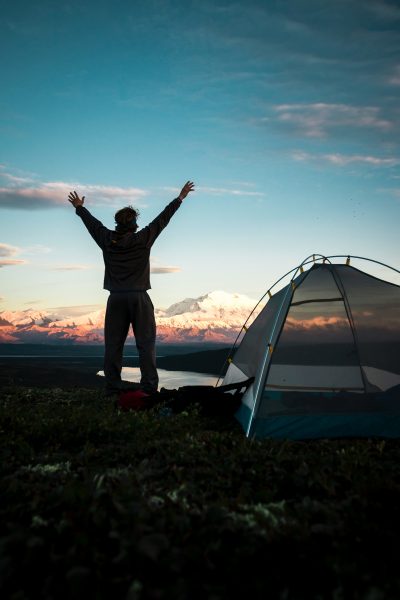Six Ways to Sleep Better While Camping
Jordan J. 09.28.21
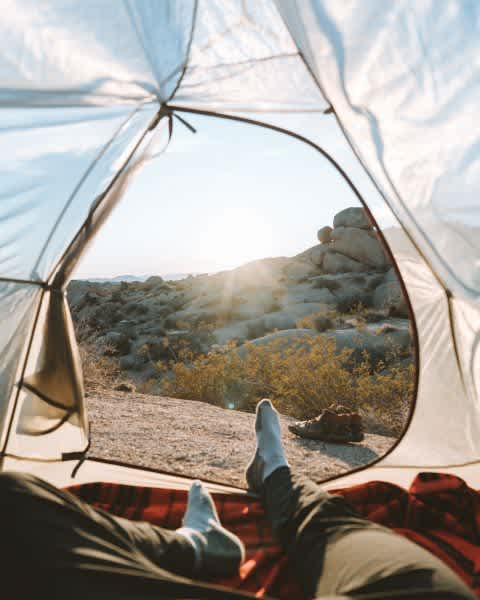
To Sleep, Perchance to Dream
It’s 2 o’clock in the morning. You’re lying in your tent, wide awake. You start to wonder many things. “Will I ever be able to fall asleep?” “Is it morning yet?” “What’s that noise?” “How is he/she sleeping so soundly?” “Why did I even go camping in the first place?” These are the thoughts that go through your brain during another sleepless night on the campground.
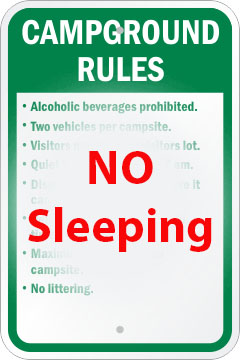
The ability to sleep well while camping is, in my opinion, the main thing that separates “happy campers” from those who dislike the activity. Anybody can pitch a tent, cook outdoors, and sit around a campfire, but if you can’t fall asleep when its time to crawl into your tent, any enthusiasm you had for camping will quickly fade.
Good news! There are a few ways to greatly improve your camping nights’ sleep, and ensure that camping is actually a restful activity (or at least, not an automatic all-nighter).
Here are six ideas to make your next camping trip more restful:
1. Use a sleeping pad.
Ironically, people who only camp occasionally often don’t have a sleeping pad — but if your body is acclimated to a comfy mattress, it’s even more important to have a portable base. Experienced campers know that a sleeping pad is one of the things you don’t want to be without. You can skip the stove, the camp chairs, the folding table — heck, you can even skip the tent, but you do NOT want to skip the sleeping pad.
While it is possible to train your body to sleep on a hard surface with no buffer, this takes time to master. If you spent last night on a Tempur-Pedic®, you might not excel on your first try. Additionally, the biggest challenge with sleeping without a pad is not the hardness of the surface, but rather the unevenness. You might think lying on your wood floor feels comfortable, but now try doing it with a few rocks under your kidneys. The Earth is not welcoming to newcomers, but a sleeping pad can soften the blows the planet throws your way.
There are a number of lightweight, inflatable sleeping pads that add little bulk to your pack and can do wonders for transforming your night of sleep. For a detailed summary of sleeping pad options, check out “The Best Sleeping Pads for Camping and Backpacking,” by Luke Cuenco.

Photo credit: Walmart.com
2. Make sure you have the right temperature gear.
One of the main reasons people struggle to sleep in a tent is that they’re either too hot or too cold. Unless you’re glamping (shame!) your tent won’t have AC or heat, so picking the right gear to match the weather and season is essential. Many people will try to sleep during the summer in a big, bulky polyester sleeping bag, and start sweating within minutes. Conversely, that same big bag may be useless against an arctic night’s chill.
For cold weather camping, pick a sleeping bag that’s rated for 20 degrees COOLER then the temperature you expect the night to reach. A little-known secret about sleeping bags is that they’re temperature rated for survival, not comfort. Therefore, a 40 degree bag will keep you alive at 40 degrees, but if you want to be comfortable at 40 degrees, get a 20 degree bag.
For camping in hot weather, I recommend skipping the sleeping bag altogether and using a sleeping bag liner instead. Sleeping bag liners are essentially lightweight, thin sleeping bags — most have zippers and stuff sacks. You can actually save a lot of space in your pack using one of these instead of a regular bag that may be too hot.
For the last ten years, I’ve used this fleece sleeping bag liner from Walmart for all my summer camping:

And, if you’re camping in an even hotter region where temperatures may stay in the 80’s and 90’s overnight, a cotton or silk sheet bag liner may be all you need:

Photo Credit: REI.com
3. Don’t let your bed get away from you.
Another challenge with sleeping in a tent is keeping your bedding setup from falling apart. When you combine a nylon tarp tent floor, polyester sleeping bag, and a plasticized sleeping pad, the “coefficient of static friction” is reduced to levels that would make a mechanical engineer giddy. You’re likely to find yourself — and your sleeping gear — sliding all over the tent. This problem is especially compounded when your sleeping area isn’t completely level, which it usually isn’t (more on that below). If you’ve ever settled into a comfortable sleeping position, only to have your sleeping pad slip out from underneath you and your sleeping bag creep down your back, then you know what I’m talking about.

Here’s a tip to keep your sleeping bag, pad, and rest from getting away from you: try putting your sleeping pad inside of your sleeping bag. That way, you and your bag won’t slip off the pad, and the extra rigidity the pad will add to the bag will keep it from moving around so much. If you don’t like sleeping directly on the pad’s rubberized surface, put the sleeping pad into a large body-pillowcase or sleeping bag liner for extra comfort.
4. Put your backpack under your knees.
If you sleep on your back, sleep experts advise sleeping with a pillow under your knees, even in a regular bed. This can be even more advantageous when camping. Elevating your knees reduces stress on your spine, and can remove tension in your lower back generated by lying on a less-than-ideal surface:
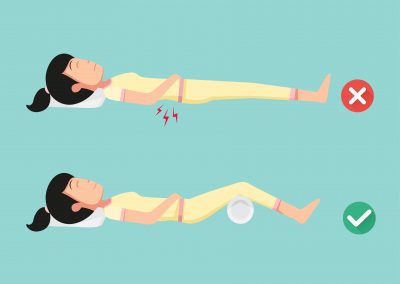
You probably won’t have a firm pillow available while camping, so sliding your backpack under your knees can be a great way to ease the tension in your back and anchor you in a more comfortable sleeping position.
5. Make sure your sleeping area is level.
If you’ve ever tried sleeping at an angle with your feet higher than your head, you know how much your body will reject this unnatural posture. Similarly, sleeping with one side higher than the other will send warning signals to your brain, keeping you awake when you want to rest. When pitching your tent, try to pick the most level area you can find.
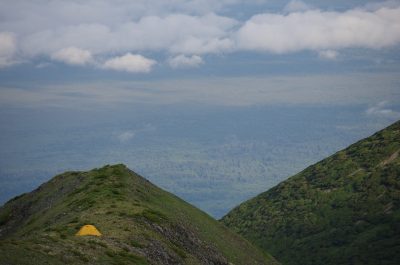
However, since it’s unlikely you’ll find a completely level spot, position your sleeping bag with your head facing uphill. This is the sloped position your body will accept most readily. Additionally, the increased friction of positioning your body parallel with the slope will reduce how far you slip downhill over night.
6. Use natural sleep aids.
When camping, melatonin is your friend. Melatonin is naturally produced by your body, and supplements are regularly prescribed for insomnia or sleep disorders. The CDC has not yet labeled “leaving your home to sleep on the ground in the woods” as a sleeping disorder, but taking melatonin when camping can be a great way to fall asleep (or fall back to sleep when that twig snapping wakes you up). There are also melatonin supplements formulated for kids, which can be useful if you have kids along on your camping trip. Kids are often too excited to sleep while camping, and if you’re sharing your tent with wide awake children, you’re probably not sleeping either.

Another natural sleep aid you can use while camping is white noise. Campers have mixed feelings about the sounds of nature when sleeping. Relaxed, experienced campers enjoy the sounds of the nocturnal environment lulling them to sleep. But for people who only camp occasionally, every owl call, every raccoon footstep, every rustle or snapped twig can jerk them out of repose and into alertness. After all, who hasn’t laid in a tent listening to a small animal rustling nearby, wondering if it was actually a bear waiting to charge?
White noise can help smooth over these unfamiliar sounds and allow you to rest. There are a number of white noise apps you can download for free and play on your phone or with earbuds:

Conclusion
You can spend tons of money on gear, travel, and picturesque destinations, but you won’t enjoy camping if you can’t sleep. Investing in a few bedtime innovations will go a long way toward making your camping trips enjoyable, and making yourself a more proficient camper. Think about what YOU need to sleep well, figure out how to make it fit in your pack or load out, and then make plans to have the best sleep of your life on your next camping trip. Or at least, the best sleep you’ve ever had in the wild.


